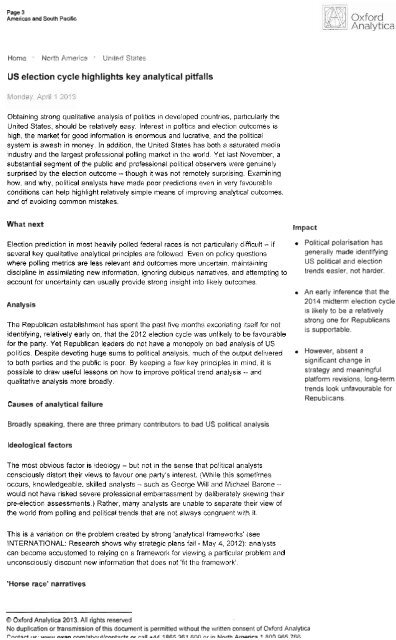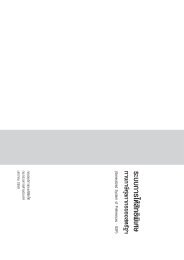i.F ..nll..i - US Watch
i.F ..nll..i - US Watch
i.F ..nll..i - US Watch
You also want an ePaper? Increase the reach of your titles
YUMPU automatically turns print PDFs into web optimized ePapers that Google loves.
Page 3<br />
Amencas and South Paufic<br />
Home Nolh Amei'cii ' Urilr-:l Sialcg<br />
<strong>US</strong> election cycle highlights key analytical pitfalls<br />
Obtaining strong qualitative anaiysis of politics in developed countries. particularly the<br />
United States, should be relatively easy. Interest in politics and election outcomes is<br />
high, the market for good information is enormous and lucrative, and the political<br />
System is awash in money. In addition, the Unibd States has both a saturated media<br />
industry and the largest professional polling market in the world Yet last November, a<br />
substantial segment of the public and professional political observers were genuineiy<br />
surprised by the election ou!come --though it was not remoteiy surprising. Examining<br />
how. and why, political analysts have made poor predictions even in very favourable<br />
conditions can help highlight relatively simpie means of improving analyttcal outcomes.<br />
and of avoiding common mistakes.<br />
What next<br />
Election prediction in most heavily polled federai races is not particularly difficuit - if<br />
several key qualitative analytical principles are followed. Even on poiicy questions<br />
where polling metrics are less relevant and outcomes more uncertain, maintaining<br />
discipline in assimilating new information, ignoring dublous narratives, and attempting to<br />
account for uncertainty can usually provide strong insight into likely outcomes.<br />
Analysis<br />
The Republican establishment has spent the past five inonths excoriating itself for not<br />
identifying, relatively early on: that the 2012 election cycle was unlikely to be favourable<br />
for the party. Yet Republican leaders do not have a monopoly on bad analysis of <strong>US</strong><br />
politics. Despite devoting huge sums to political analysis, much of the output de!ivered<br />
to both parties and the public is poor. By keeping a few key principles in mind. it is<br />
possible to draw useful lessons on how to improve political trend analysis -- and<br />
qualitative analysis more broadly.<br />
Causes of analytical failure<br />
Impact<br />
. Political poiarisation has<br />
generally made identifying<br />
<strong>US</strong> political and election<br />
trends easier, not harder.<br />
. An early inference that the<br />
2014 midlerm election cycle<br />
is iikeiy to be a relatively<br />
strong one for Republicans<br />
is supportable.<br />
. However, absent a<br />
significant change in<br />
strategy and meaningful<br />
platform rev!sions, long-term<br />
trends look unfavourable for<br />
Repubilcans<br />
Broadly speaking, there are three primary contributors to bad <strong>US</strong> political analysis<br />
Ideological factors<br />
The most obvious factor is ideology - but not in the sense that political analysts<br />
ConscioiIsIy distort their views to favour one party's interest. (While this sometimes<br />
occurs, knowledgeable, skiiled analysts -such as George Wil and Michael Barone --<br />
would not have risked severe professional embarrassment by deliberately skewing their<br />
pre-election assessments.) Rather. many analysts are unable to separate their view of<br />
the world from polling and political trends that are not always congruent with it^<br />
This is a variation on the problem created by strong 'analyticai frameworks' (see<br />
INTERNATIONAL: Research shows why strategic plans fail -May 4, 2012) analysts<br />
can become accustomed to relying on a framework for viewing a particular problem and<br />
unconscioitsly discount new information that does not 'fit the framework'.<br />
'Horse race' narratives<br />
O Oxford Analytic8 2013. All rights reserved<br />
NO duplication or transmission of this doci!me!it is permitted without the written consent of Oxford Analyllca<br />
C ~ ~ . i.F l ~ ..<strong>nll</strong>..i ~ l rnml.l\nlilir~nt.ir+r roll -Ad ISEF. If < Gnn nr ;& hlnith 7 Uiln OEF; 71iP
Page 4<br />
Amedcxsand SoUth PaMc<br />
The <strong>US</strong> media oflen contributes to these false narratives because its prtmaly objective<br />
(telling an exciting political story) differs from that of professional analysts (gauging the<br />
likely outcome of the election). Thus, in relatively static elections such as the 2012<br />
presidential contest: the media has a strong iiicentive to over-interpret small, frequently<br />
insignificant, polling movements as indicative of a major shifl in trend.<br />
Misuse of history<br />
Finally, it is tempting to misuse historical 'precedent' In analysis of <strong>US</strong> elect~ons In the<br />
history of modern polling there have been just 20 presidential election cycles. Seeking<br />
to draw conclusions utilising a dataset with so few data points should be undertaken<br />
with considerable caution.<br />
However, political analysts often 'cherry pick' this iimited historical data to support<br />
sometimes dubious conclusions. For exampie. during the 2012 cycle some analysts<br />
emphasised the fact that no tncumbent president had won re-election since 1940 when<br />
the official unemployment rate exceeded 7.3%. Yet given the iimited dataset and the<br />
fact that Franklin Roosevelt won re-election (1836 and 1940) twice when unemployment<br />
was at least double that rate (16.6% and 14.6% respectively). the usefulness of this<br />
historical correlation was certainly over-emphasised (see UNITED STATES: Romney<br />
faces uphill campaign fight - August 27. 2012) and see UNITED STATES: Ohama<br />
retains edge over challengers - December 16, 2011).<br />
Improving analysis<br />
VVith a little effort to contain these negative tendencies. the accuracy of politicai trend<br />
analysis can be improved.<br />
Information assimilation<br />
As statistician and polling analyst Nate Silver explained in his 2012 book. 'The Signal<br />
and the Noise', good qualitative anaiysts adjust their assessments in response to<br />
additional data. In contrast, poor analysts have a tendency to stlck to their previous<br />
conclusions regardless of new data -- or, even worse: interpret all new data in a manner<br />
that simply reinforces their previous conclusions (behaviourai economists call this<br />
'confirmation bias').<br />
One of the best qualitative anaiysts of <strong>US</strong> politics. Charlie Cook of the Cook Political<br />
Report, has since 1984 been correct approximately 92.95% of the time in competitive<br />
congressional and presidential races. In early 2011, he suggested that 2012 couid be a<br />
good year for Repubiicans. Yet, critically. as more polling atid other data becanie<br />
available, his assessment shifted completely -- and ended up being very accurate<br />
several weeks before 2012 eleclions<br />
Weighing data<br />
Not all data is equally significant. While <strong>US</strong> pollsters hardly have a perfect record. they<br />
are both the single most reliable barometer of publlc opinion and an accurate guide to<br />
nationai election outcomes - when their resuits are assessed a few days ahead of an<br />
election and aggregated. (On the other hand. cherry pick~ng individual polls -- some of<br />
which will necessarily be highiy inaccurate outliers - freqiiently leads to serious<br />
failures.) There have been a few cases when polling has, for various reasons, been<br />
systematically wrong: but if an analyst believes this is happen~ng it is incumbent ilpon<br />
them to explain why.<br />
@Oxford Analvlica 2013. All rights reserved
O Oxford Analytica 2013. All rights reserved<br />
No duplication or tra!rsmission of this document is perlnitted without the written consent oiOxford Analytica<br />
Cnntnd iua. www oran cornlaholrtlcontartn or rnil +44 lilt35 261 ROO oi in Norllr America 1 800 965 766<br />
Page 5<br />
Arnerlcasand South Pauflc<br />
In the current, highly polarised, political environment, demographic data is also a useful<br />
analytical guide. since the behaviour of particular voting blocs is increasingly consistent.<br />
However, the media teiids to downplay polling and demographic data in favour of a focus<br />
on campaign strategy and tactics. In local campaigns, these strategies can be highlight<br />
significant to the outcome, but in presidential contests there is relatively little polling<br />
data to support the notion that campaign tactics had a decisive impact on the general<br />
election outcome since the late 1980s.<br />
Accounting for uncertainty<br />
Finally. in is incumbent upon an analyst to gauge, and be clear about, the uncertainty<br />
inherent in any political trend assessment. Such uncertainty is, of course. much greater<br />
the further into the future the projection: more than two months before the polls, any<br />
projection should be treated as highly speculative. However, as Election Day<br />
approaches, the risk of disruptive contingencies subsides and polling data has far more<br />
predictive power. At that point, if the aggregate polling data indicates a clear leader. it<br />
becomes disingenuous and potentially unsupportable to maintain that the race is 'too<br />
close to call'.<br />
Outlook<br />
Media fragmentatlon, a changing business model for pollsters, and an increasingly<br />
poiarised and ideologically entrenched electorate means that the overall quality of <strong>US</strong><br />
political analysis is likely to remain poor. Nevenheless there are a small number of<br />
exceptionally high quality analysts at work in this discipline; all tend to alter the~r<br />
conclusions when confronted with new data, assimilate information effectively, and have<br />
a solid grasp of how to measure uncertainty<br />
Word Counf (approx): 1203





